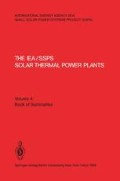Summary
High-flux sodium-cooled receivers have low thermal inertia and short response times. Controls must keep the outlet temperature constant at changing power levels, without compromising structural integrity. The Advanced Sodium Receiver (ASR) and its controls are designed to accomplish this; it is of interest to determine how close performance approaches expectations.
Access this chapter
Tax calculation will be finalised at checkout
Purchases are for personal use only
Author information
Authors and Affiliations
Editor information
Editors and Affiliations
Rights and permissions
Copyright information
© 1986 Springer-Verlag GmbH Berlin Heidelberg
About this chapter
Cite this chapter
Carmona, R., Martín, J.G. (1986). The SSPS Advanced Sodium Receiver: Transient Response. In: Kesselring, P., Selvage, C.S. (eds) The IEA/SSPS Solar Thermal Power Plants — Facts and Figures— Final Report of the International Test and Evaluation Team (ITET). Springer, Berlin, Heidelberg. https://doi.org/10.1007/978-3-642-82684-9_18
Download citation
DOI: https://doi.org/10.1007/978-3-642-82684-9_18
Publisher Name: Springer, Berlin, Heidelberg
Print ISBN: 978-3-540-16149-3
Online ISBN: 978-3-642-82684-9
eBook Packages: Springer Book Archive

